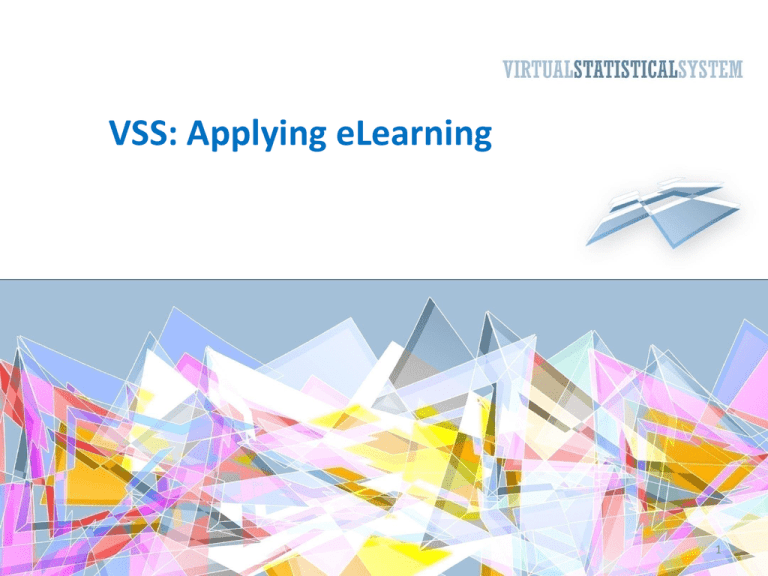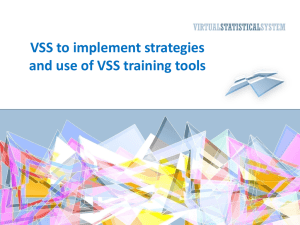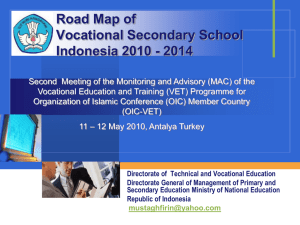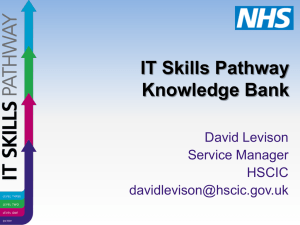VSS and applying eLearning
advertisement

VSS: Applying eLearning 1 Introduction • This lesson is about how the VSS training tools can be used by individuals and organizations. • Organizations can be National Statistical Offices or other statistical agencies, or training institutes. • Individuals can be students, researchers, or practitioners. • Organizations can integrate the tools in their training approaches. • Training approaches are: classroom training, on line group e-Learning. 2 Training needs • Organizations first have to define their training needs. – whereas staff member can identify personal training needs – heads of units can define “unit-training-needs”. • Training needs can be subdivided into types of training: – Individual and group, – theoretical and practical • Result is a complete list of training needs by staff members, units and with defined topics. • The topics of the list can be matched with the available VSS training tools (topic-wise) and types of training. • Result is a confrontation of training needs and types in numbers and available VSS training tools. 3 Matching training needs with supply Training needs demand Division, Unit Topic (Project A). • WBS activity = survey design. • Staff names. • Training needs (1, 2, 3, 5 n) • Training types (1-2-3-4). Division, Unit Topic (Project B). • WBS activity = management. • Staff names. • Training needs (1, 2, 4, 5, n) • Training Types (1-2-3-4). Training supply. • Training types: – General Types (M) and – Specific Types (N) • Training Topics – (M 1, 2, 3, n) – (N 1, 2, 3, n) 4 Available VSS training tools Courses on: Forms: presentations with voices and power points. - Management of Statistical Systems Project Management of Statistical Surveys GIS • • • Presentations/ Power Point 20 lessons Presentations/ Power Point 24 lessons Power Point 6 lessons - Labor Statistics and Survey Design Justice, Security and Crime Statistics Quality Assurance of the Census • • • Voiced over Power Point Voiced over Power Point Power Point 20 lessons 20 lessons 20 lessons - Agriculture Statistics Business Statistics and Business Register System of National Accounts (intro) System of National Accounts (advanced) Government Finance Statistics • • • • • Power Point Power Point Power Point Power Point Power Point 20 lessons 20 lessons 10 lessons 10 lessons 20 lessons 5 VSS eLearning modes Online eLearning • Self paced Facilitated • Self paced online • Facilitator / expert Blended Classroom situation • Combination of • Online mediated • Face to face (classroom) • Groups within organizations • Facilitator / Teacher • eLearning online platform 6 How to apply the VSS materials for NSOs • The present selection is a list of basic information which is relevant to all national statistical organizations. • This approach can be extended and additional courses can be added. • Classroom use of the lessons is one good option. • Self paced distance learning is always possible. • Full scale distance learning still needs to be developed. 7 Integrating VSS study materials into training approaches • A country or organization should draw up a training plan. • Training plans are bases on a curriculum: – – – – a list of training objectives, materials, exercises and modes of delivery. • Typically training in development should deal with management issues and subject matter issues. • Different training modes can be considered. 8 Proposal for applying VSS tools in classroom mode • Form a group of students, based on needs assessments. • Select 2 priorities from e.g. the NSDS • Use the Project Management Approach with a WBS. – (WBS is Work Breakdown Structure allowing definition of separate “activities” or steps of the project.) • First define steps, do the WBS, and create these “activities”. • Formulate “activity” related information needs and outcomes. • Link group exercises to the learning objectives. • Use VSS materials to make project design • Link VSS eLearning to VSS knowledge base • Use tests to evaluate groups and individuals 9 Proposal to use VSS materials by training institutes • Training institutes have their own curriculum. • Still the VSS could be used effectively. • Steps to take: – Match the existing trainings with the VSS eLearning tools. – Examine how these tools can fit into available trainings. – If needed, new training courses can be developed based on the VSS materials. 10 Training of trainers • Both, NSOs and training institutes should consider to train VSS trainers. • Training trainers aims at easy way of knowledge transfer with a multiplying effect • First VSS trainers are trained, which later train other staff. • Courses in which trainers are trained are special courses. • More attention should be given to the transfer of knowledge and skills. 11 To realize the use of the VSS tools: • The VSS approach needs – Champions – Training of VSS Trainers – national focal points – to be integrated in national training programs – to show value added on a continuous basis. 12 VSS eLearning: Blended approach. • Distance learning courses are most effective when followed by many, up to 70. • Incentives for completion should be considered (certificates, other rewards) • Incentives for successful completion should be created to increase motivation (e.g. face-toface workshops for the most successful students) 13 Learning and TA should be linked • The best way is to link the learning to existing needs and projects of change. • Projects of Change are TA projects. • Even the work program with projects can be linked to a training program. • Projects should be broken down into WBS activities. • The VSS courses can be linked to these project activities. • Needed and missing courses can be designed and added. 14 Example of a coordinated VSS training approach (see matrix below) • A list can be made from the knowledge domains for which training is needed. • For each domain two projects can be considered. • Each project has to be broken down into the WBS activities (steps). These activities need to be listed. • For each of these activities training needs and the deliverance of VSS training can be defined. • Some project activities can be supported completely by the VSS, others only partially. • For certain topics like mathematics and ICT very specific support needs to be delivered. Tailor made input might be needed. 15 VSS eLearning Project Management Matrix Approach Example for use of VSS tools in an implementation project for e.g. NSDS Knowledge domain Management Integration Frameworks Economic Statistics Social Statistics Mathematics ICT Type of project Man 1 Man 2 IntFram 1 IntFram 2 EcoStat 1 EcoStat 2 SocStat 1 SocStat 2 Math 1 Math 2 ICT 1 ICT 2 Production processes in statistics Step 1 VSS input VSS input VSS input VSS input VSS input VSS input VSS input VSS input Step 2 VSS input VSS input VSS input VSS input VSS input VSS input VSS input VSS input other input 1 Step 3 VSS input VSS input VSS input VSS input VSS input VSS input VSS input VSS input Step 4 VSS input VSS input VSS input VSS input VSS input VSS input VSS input VSS input other input 2 other input 1 other input 1 other input 1 Final Step 5 VSS input VSS input VSS input VSS input VSS input VSS input VSS input VSS input Results other input 2 other input 2 other input 2 16 eLearning in developing countries • Can it work? Yes it can! It is proven! • Technical problems need to be addressed • Materials can be delivered in form of CD Rom’s and DVD’s • Organizations support: draft MOUs • Install VSS eLearning coordinators. • Get good facilitators and experts. • Let staff share their knowledge. • Give VSS students a future (certified resource person). • Finally: make it exciting – link lessons to reality. 17









